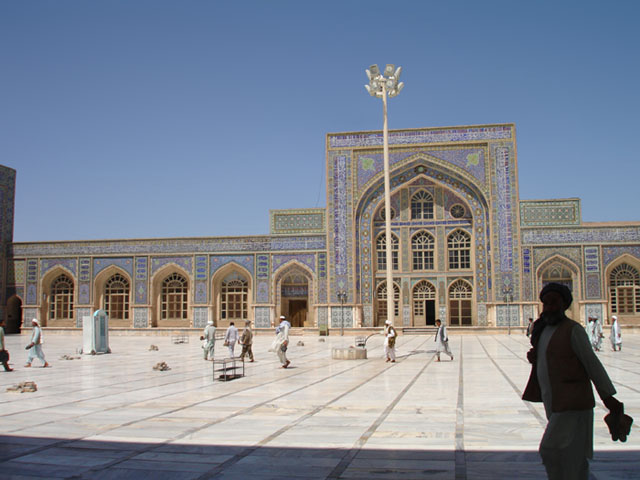For seven centuries the people of Herat have prayed in it. They still do so, and its history is their history.
On the 25th of November 1933, after nearly two months into his journey in Iran and Afghanistan, Robert Byron finally visited his first Friday Mosque: the Masjid-i Jami’ of Herat. And it happened apparently by chance: he was determined to leave the city on that day, but, as he reports in his travelogue, rain prevented him from continuing his journey.

Technically, this is not the first congregational mosque Byron visited: he had seen the wreck of the Friday Mosque of Varamin at the beginning of his journey. But the Masjid-i Jami’ of Herat was certainly the first active Friday Mosque. For this reason, Byron takes some time in his journal to explain to the reader what a Friday Mosque is, and, as he frequently does, he finds a Western counterpart:
Masjid-i-Juma means Friday Mosque. Every town has one. It corresponds to a parish church or metropolitan cathedral according to the size of the place, and is generally the oldest, and often the biggest building there. As in a European town, whose abbey or cathedral still proclaims the Middle Ages, while the rest has changed with the times, so in Herat this morose old mosque inside the walls growls a hoary accompaniment to the Timurid pageant of the suburbs.
It is also true that at the time Byron visited it, the mosque still “proclaim[ed] the Middle Ages”, even if, also in its early history, the mosque had been rebuilt, restored and modified frequently by the various rulers of the city. Similarly to what happened with the Citadel.
The present mosque was begun in 1200 by the Ghurid ruler Ghiyath al-Din Muhammad bin Sam (1162-1202), and continued, after his death, by his brother and successor, Shihab al-Din. It is thought that the mosque was built on the remains of two destroyed Ghaznavid mosques. That same century, Genghis Khan pillaged the city and destroyed the mosque, that was subsequently rebuilt and restored by the Kart rulers in 1306. When the Timurid arrived, the mosque was in ruin: in Byron’s words “The Friday Mosque was old and ruined before the Timurids were heard of. It is less ruined now they are not heard of”.
The Timurids actually repaired the mosque, but incidentally, they had other plans for the city of Herat: after 1397 they redirected the expansion of the city, and the mosque was no longer a central feature of it. Furthermore, the Timurids started the construction of the Musalla Complex, and in particular of the mosque of Gawhar Shad: this shifted the priorities of the royal patronage.
After Byron’s visit, the Friday Mosque of Herat underwent yet another cycle of substantial renovation part of a larger urban project, so extensive that nowadays there is little to authenticate as “original”.
The extent of the twentieth-century renovation is clear when comparing the photos Robert Byron took with those taken at a later date.




In this regard, Byron photo’s and travel account have both the important task to help us reconstruct the past.
Sources and for further reading
Archnet.org as always provides further information over the architecture of the mosque and a huge photo gallery.
Terry Allen, Timurid Herat, Reichert, Wiesbaden 1983.
Melikian Chirvani,. “Eastern Iranian Architecture: Apropos of the Ghurid Parts of the Great Mosque of Herat”, in Bulletin of the School of Oriental and African Studies, 33-2 (1970), pp. 322-27.
Richard N. Frye, “Two Timurid Monuments in Herat”, in Separatum Artibus Asiae, XI/3 (1948), pp. 206-12.
Lisa Golombek, “The Resilience of the Friday Mosque: The Case of Herat”, in Muqarnas: An Annual on Islamic Art and Architecture, I (1983), pp. 95-102. [available online, last accessed Dec 12th, 2017]
2 Comments Add yours